How to Grow Cornflowers
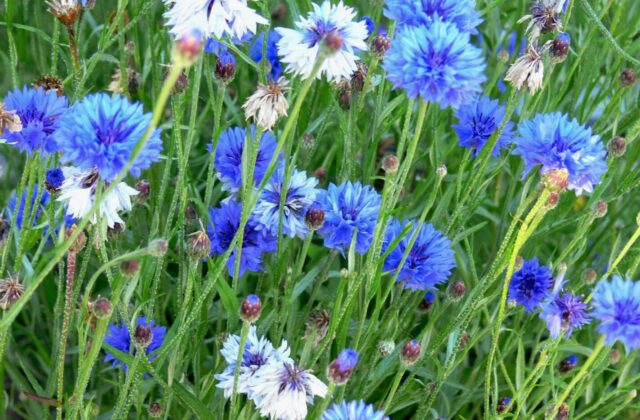
Introduction
Cornflowers, scientifically known as Centaurea cyanus, are charming annual plants renowned for their delicate beauty and vivid blue hues. Native to Europe, these enchanting flowers have captured the hearts of gardeners and admirers worldwide with their striking appearance and cultural significance. When considering how to grow cornflowers, it’s essential to understand the ideal growing conditions. Often found adorning fields, gardens, and even traditional folk attire, cornflowers have woven themselves into the fabric of various cultures, symbolizing qualities ranging from love and fertility to remembrance and luck. With their dainty petals and slender stems, cornflowers are a testament to nature’s artistry, inviting observers to immerse themselves in their timeless allure and captivating symbolism. In this article, we will learn how to grow cornflowers and explore the fascinating world of cornflowers, delving into their origins, characteristics, symbolism, and cultural significance.
Cornflower Types
Cornflowers (Centaurea cyanus) are beloved for their vibrant colors, easy cultivation, and versatility in various garden settings. Here are some types of cornflowers along with details about each:
Standard Blue Cornflowers
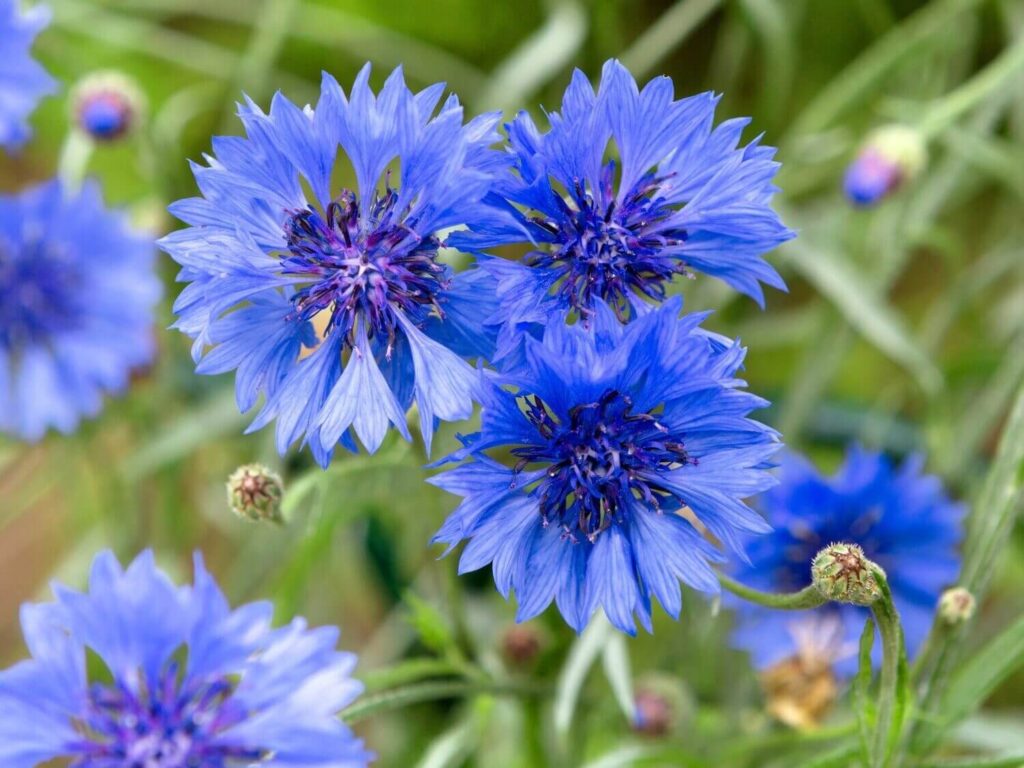
These are the classic cornflowers, often seen in meadows and wildflower gardens. They have striking, vivid blue petals surrounding a contrasting center. Standard blue cornflowers typically grow up to 2-3 feet tall and bloom in summer.
Double-Flowered Cornflowers
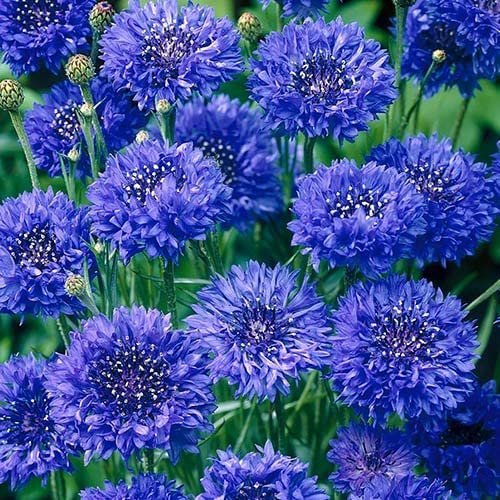
Double-flowered varieties feature densely packed petals, giving them a fuller appearance compared to the single-flowered types. These cultivars offer a more ornamental look and are popular for cut flower arrangements.
Tall Cornflowers
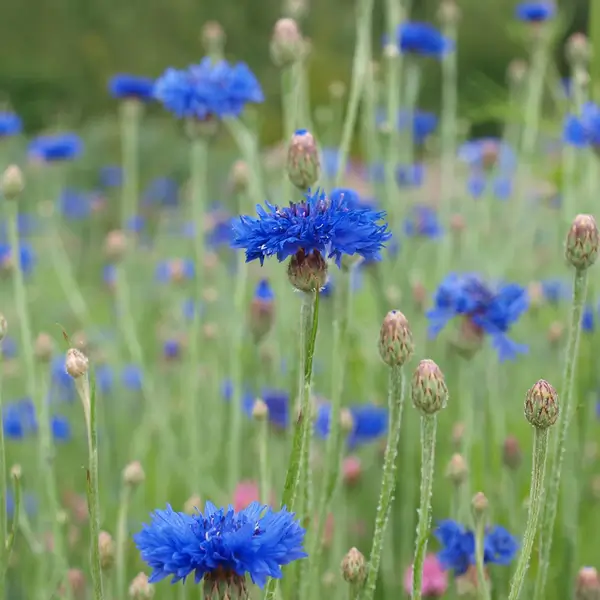
Tall cornflowers are characterized by their height, often reaching over 3 feet tall. They produce abundant blooms on sturdy stems, making them ideal for creating dramatic backdrops in garden beds or borders.
Dwarf Cornflowers
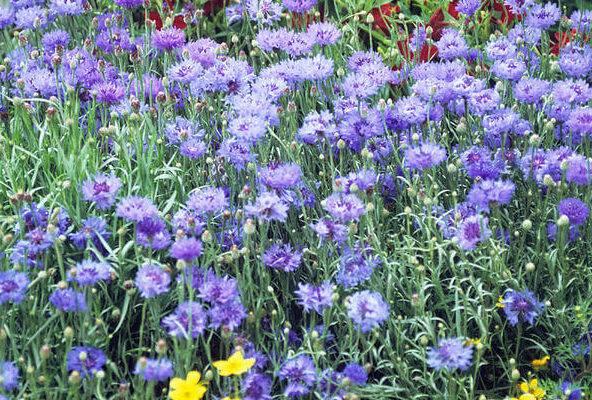
Dwarf cornflowers are compact varieties that stay shorter in height, typically under 1 foot tall. They are perfect for small gardens, containers, or as edging plants along pathways.
Perennial Cornflowers
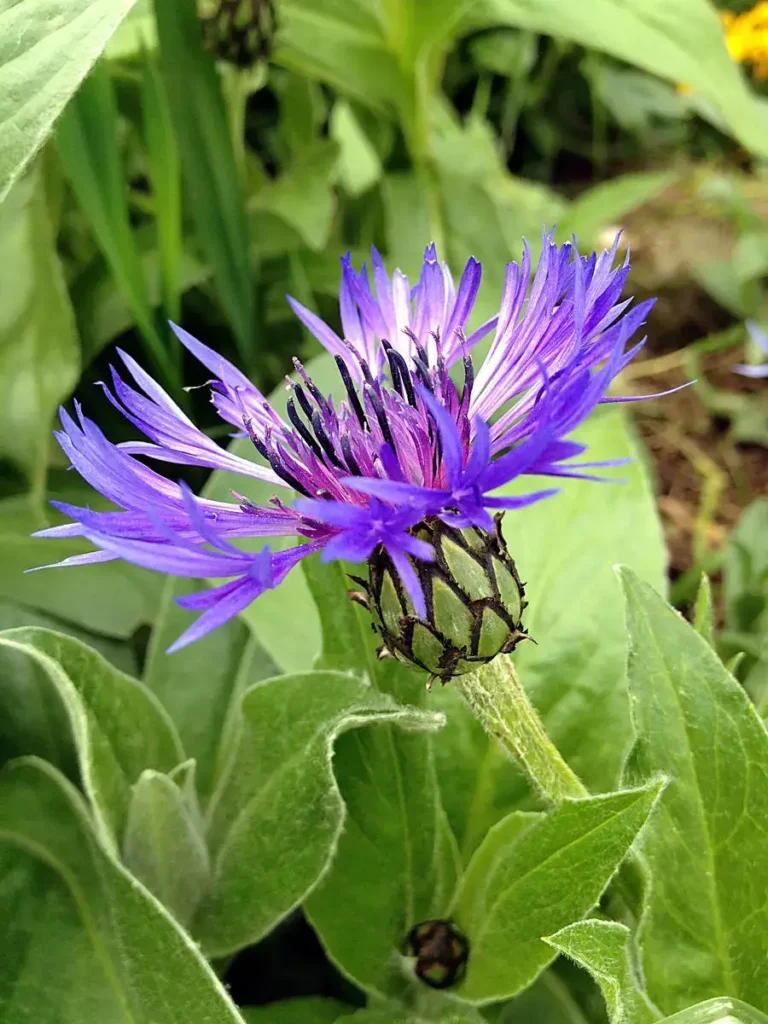
While most cornflowers are grown as annuals, there are perennial species and cultivars available as well. Perennial cornflowers come back year after year, offering long-lasting color in the garden.
Wild Cornflowers
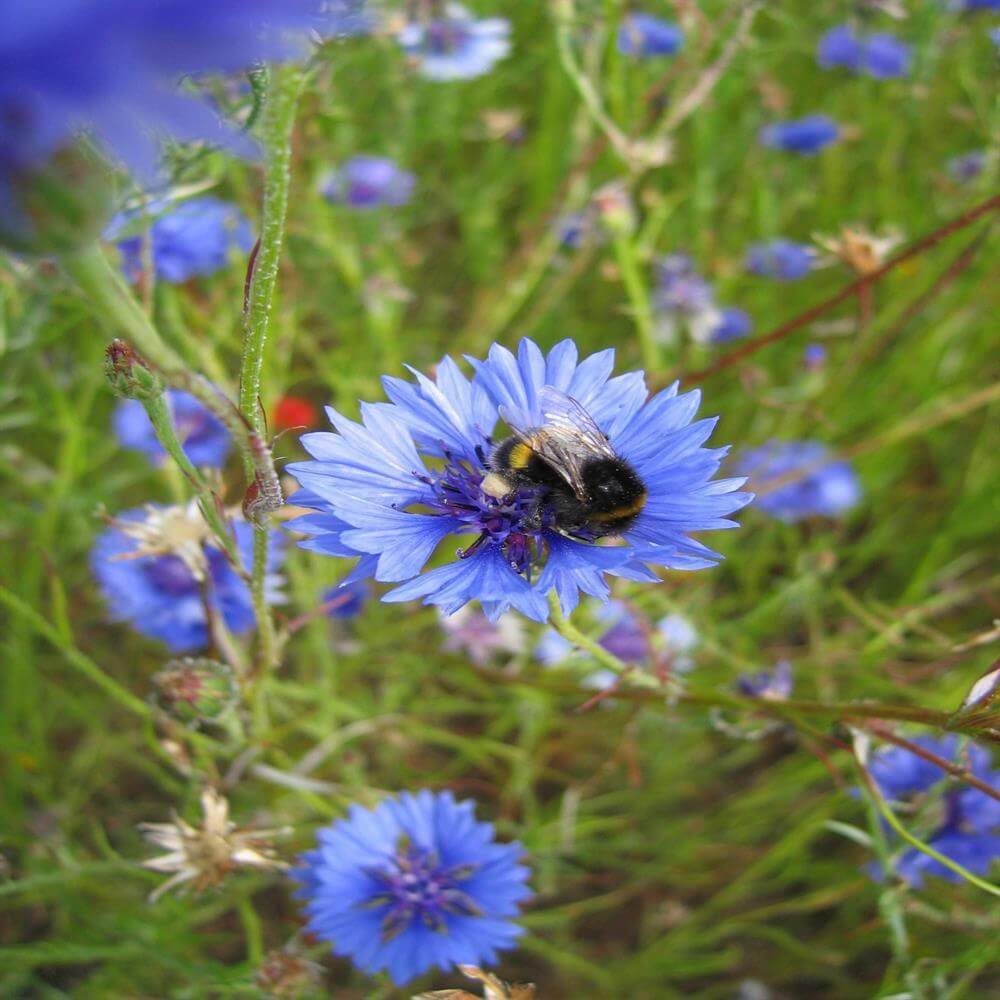
Wild cornflowers are native species found in various regions. They often have smaller flowers and slightly different growth habits compared to cultivated varieties. Wild types contribute to naturalistic garden designs and are valuable for supporting local pollinators.
Specialty Cornflowers
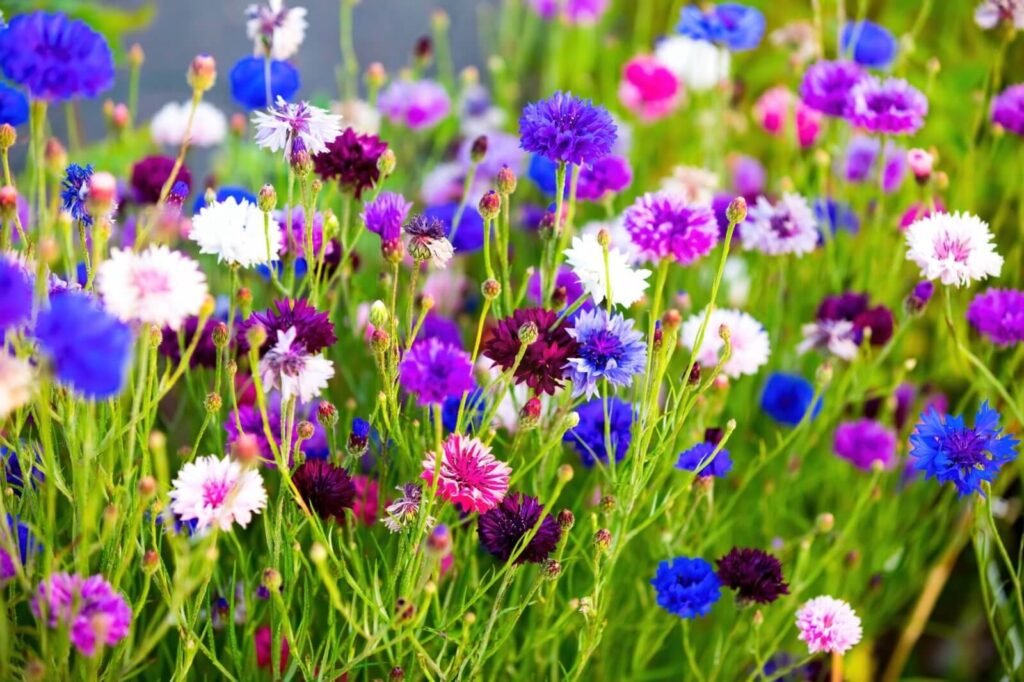
Specialty cultivars come in a range of colors, patterns, and sizes, offering diverse options for gardeners. These may include unique flower colors such as pink, white, red, or purple, as well as bi-color or multi-color varieties.
Each type of cornflower has its characteristics, making them suitable for different garden styles, purposes, and preferences. Whether you’re looking for classic blue blooms, compact plants for containers, or perennial varieties for long-term garden enjoyment, there’s a cornflower variety to suit your needs.
Successfully Cultivating Cornflowers
Choosing the Right Location
When cultivating vibrant cornflowers, it’s essential to select a location with full sun exposure to ensure vibrant blooms. Consider areas with well-draining soil to prevent waterlogging, which can be detrimental to cornflowers. Also, avoid locations with excessive shade, as it can inhibit the growth and flowering of cornflowers. Lastly, choosing a spot that is protected from strong winds is crucial to prevent damage to the delicate stems and petals of cornflowers. By keeping these pointers in mind, you can set the perfect stage for your cornflowers to thrive and bloom vibrantly.
Understanding Sunlight Needs
When cultivating vibrant cornflowers, selecting a location with ample sunlight is crucial. Cornflowers thrive in direct sunlight for at least six hours a day, promoting the development of sturdy stems and richly pigmented blossoms. It’s important to ensure that the chosen spot is not obstructed by large trees or buildings, as insufficient sunlight can lead to leggy growth and lackluster flowers in cornflowers. By prioritizing adequate sunlight, you can set the stage for your cornflowers to flourish with vibrant and captivating blooms.
Considering Soil Conditions
A key aspect of learning how to grow cornflowers is providing them with the right soil conditions and sunlight exposure. It’s crucial to prioritize the soil conditions to ensure optimal growth and development. Opt for well-drained soil with good fertility levels to support healthy root development in cornflowers. Evaluate the soil’s pH level, aiming for slightly acidic to neutral conditions within the range of 6.0-7.0 to promote robust growth. Additionally, loamy soil enriched with organic matter is ideal, as it promotes optimal moisture retention without waterlogging, benefiting the cultivation of vibrant cornflowers. It’s imperative to avoid compacted or clay-heavy soils that impede drainage and ventilation, as they can potentially cause root rot in cornflowers, hindering their overall health and vibrancy.
Planting Techniques
When preparing the soil for cultivating vibrant cornflowers, it’s important to start by clearing the area of any weeds and debris to create an ideal environment for their growth. Choosing a sunny location with well-draining soil is essential to ensure optimal conditions for the cornflowers to thrive. To provide consistent moisture without wetting the foliage, consider using a soaker hose or drip irrigation system, promoting healthy growth. Additionally, applying a balanced fertilizer sparingly at the time of planting will provide the essential nutrients for robust cornflower plants, setting the stage for vibrant blooms to grace your garden.
Seed Sowing Depth
Gardeners often wonder how to grow cornflowers from seed, and it’s simpler than you might think. After preparing the soil, sow cornflower seeds at a depth of approximately 1/4 inch to facilitate successful germination. It’s important to avoid sowing the seeds too deep, as this can hinder germination and delay the emergence of delicate cornflower seedlings. Once sown, gently firm the soil over the seeds to secure them in place while maintaining proper soil contact for optimal growth. Afterward, water the newly sown seeds gently to settle the soil and provide essential moisture for the initial stages of growth, ensuring the ideal conditions for vibrant cornflowers to flourish.
Spacing for Growth
To ensure optimal growth and vibrant blooms, it’s essential to space cornflower plants about 12 inches apart, allowing for ample air circulation and preventing overcrowding as they mature. Similarly, maintaining proper spacing between rows, typically around 18 inches, facilitates easy access for maintenance and harvesting when necessary. Enhance space utilization by interplanting with companion flowers or herbs, maximizing your garden while attracting beneficial insects for natural pest control. As your cornflowers flourish, keep a close eye on plant spacing and thin out any overcrowded areas to maintain healthy and vibrant blooms.
Watering and Maintenance
Consistently watering your cornflowers is essential to promote healthy growth and vibrant blooms. It’s crucial to keep the soil moist without allowing it to become waterlogged, ensuring optimal conditions for their development. Regularly checking the soil moisture level by feeling the top inch of the soil is a great way to gauge when it’s time to water your cornflowers. Additionally, applying a balanced liquid fertilizer every 4-6 weeks during the growing season will provide essential nutrients for robust cornflower plants, supporting their overall health and vitality. To encourage continuous blooming throughout the season, make sure to remove spent flowers by deadheading regularly, allowing your cornflowers to showcase their vibrant blooms to the fullest.
Proper Watering Schedule
Establishing a consistent watering schedule is crucial when cultivating vibrant cornflowers. Aim for an inch of water per week, whether from rainfall or manual watering, to ensure even moisture for the plants. Water deeply but infrequently to promote deep root growth and drought tolerance, typically once a week depending on weather conditions. It’s important to avoid overhead watering to prevent foliage diseases. Instead, use a soaker hose or water at the base of the plants to keep the leaves dry. Additionally, be sure to adjust the watering frequency based on environmental factors such as temperature, humidity, and soil drainage to maintain optimal moisture levels and support the vibrancy of your cornflowers.
Weed Control and Pruning
It’s important to regularly remove weeds around your cornflowers to prevent competition for nutrients and space. Consider hand-pulling or mulching as effective methods. Additionally, prune back any overcrowded or dead stems to improve air circulation and reduce the risk of pests and diseases. To further support healthy plant development, mulch around the cornflowers with organic materials like straw or wood chips to suppress weed growth and retain soil moisture. Lastly, make a habit of inspecting your plants regularly for signs of disease or pest infestations, promptly removing affected parts and disposing of them properly. These proactive measures will contribute to vibrant, healthy cornflower plants in your garden. By following expert advice on how to grow cornflowers, gardeners can enjoy an abundance of colorful flowers throughout the season.
Fostering Healthy Growth
Cornflowers thrive when planted in well-drained, fertile soil with a pH level between 6.0 and 7.0, providing them with the essential nutrients for healthy growth. Regularly deadheading faded blooms not only keeps the garden looking tidy but also encourages continuous flowering throughout the growing season. Additionally, applying a balanced liquid fertilizer every four weeks provides the necessary nutrients for robust growth and abundant blooms. After each blooming cycle, consider pruning the cornflowers to maintain their shape and stimulate new growth, ensuring they remain vibrant and healthy. These practices are key to cultivating vibrant and flourishing cornflowers in your garden.
Nutrient Requirements
Cornflowers benefit from a general-purpose, slow-release fertilizer applied in early spring to support their nutrient needs. Incorporating organic matter like compost into the soil before planting provides essential nutrients for healthy root development. Additionally, a phosphorus-rich fertilizer can aid in enhancing flower production and overall plant vigor. Maintaining proper soil moisture levels is crucial for ensuring effective nutrient uptake by the cornflowers, ultimately contributing to their vibrant growth and abundant blooms. These practices are essential for providing the necessary nutrients for robust and flourishing cornflower plants in your garden.
Managing Pests and Diseases
Regularly inspecting your cornflowers for aphids and spider mites is essential in preventing infestations that could hinder their growth and flowering. Implementing companion planting with marigolds or alliums not only deters common pests but also promotes a healthier growing environment for your cornflowers. Additionally, utilizing organic pest control methods like neem oil or insecticidal soap provides effective treatment without harming beneficial insects, ensuring the well-being of your garden ecosystem. Furthermore, practicing good air circulation around the plants significantly reduces the risk of fungal diseases such as powdery mildew, further safeguarding the vibrancy and vitality of your cornflowers.
Conclusion
In conclusion, cultivating vibrant cornflowers requires careful consideration of the planting location, sunlight needs, and soil conditions. Implementing proper seed sowing depth and watering techniques is vital for healthy growth while maintaining a consistent watering schedule and implementing weed control and pruning practices are essential for promoting vibrant and flourishing cornflowers. Mastering the art of how to grow cornflowers enriches the garden with beauty, attracting pollinators and adding charm to the landscape. Fostering healthy growth through nutrient requirements and managing pests and diseases is crucial for ensuring robust and abundant blooms. By following these comprehensive techniques and strategies, you can unlock the secrets to successfully cultivating vibrant and thriving cornflowers in your garden.
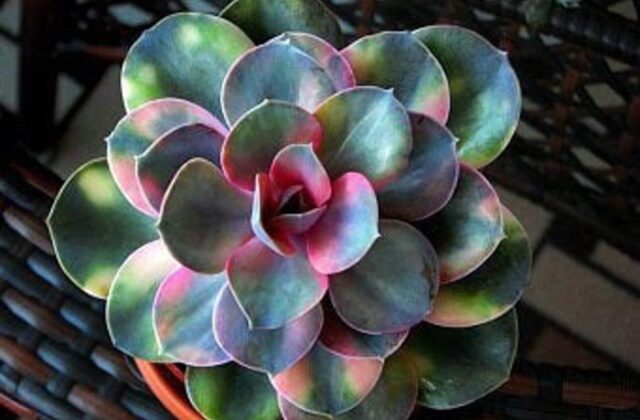
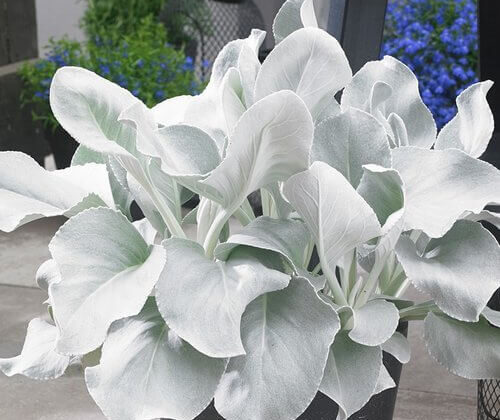
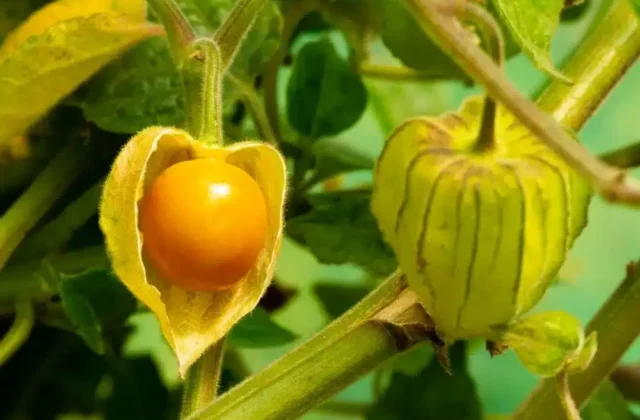
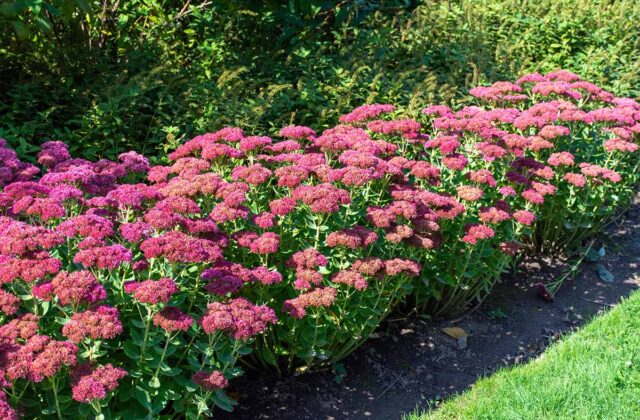
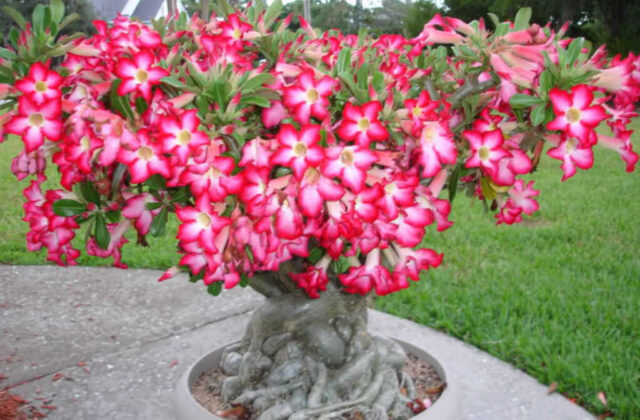
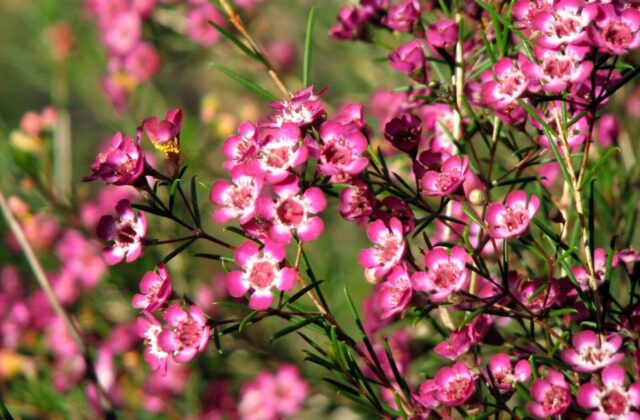
360 comments
Today, I went to the beach front with my kids. I found a sea shell and gave it to my 4 year old daughter and said “You can hear the ocean if you put this to your ear.” She placed the shell to her
ear and screamed. There was a hermit crab inside and it pinched her
ear. She never wants to go back! LoL I know this is totally off topic but I had to tell someone!
Feel free to surf to my page vpn 2024
Hi, i think that i saw you visited my site thus i came to return the
want?.I am attempting to to find issues to improve
my site!I guess its good enough to use some of your ideas!!
Feel free to surf to my web site … vpn special code
Amazing blog! Is your theme custom made or did you download
it from somewhere? A theme like yours with a few simple
tweeks would really make my blog stand out. Please let me know where you got your design. Thanks a lot
my site … vpn special
Excellent goods from you, man. I have understand your stuff previous to and you’re just extremely wonderful.
I really like what you have acquired here, certainly like what you’re saying and the way in which you
say it. You make it enjoyable and you still care for
to keep it smart. I can not wait to read much more from you.
This is actually a tremendous web site.
Feel free to visit my homepage :: vpn coupon 2024
Great items from you, man. I have bear in mind your stuff prior to and you’re simply extremely magnificent.
I actually like what you have bought here, really like
what you are stating and the way during which you are saying it.
You make it enjoyable and you continue to take care of to keep it
sensible. I can’t wait to read much more from you.
This is actually a wonderful web site.
Also visit my blog post – vpn special coupon code 2024
This is really interesting, You are a very skilled blogger.
I have joined your rss feed and look forward to seeking more of your excellent post.
Also, I have shared your website in my social networks!
my site – vpn special coupon
buy valtrex online usa
prednisone 2 5 mg
how to get prednisone over the counter
cialis pharmacy coupon
can i buy valtrex online
200 mg prednisone
prednisone 1 mg coupon
The individuals who work for IG Take are very professional.,easy to speak too and very cooperative.
tadalafil 5 mg coupon
batmanapollo.ru
I’m thoroughly impressed by the depth of your analysis in this post. Your perspective is both unique and enlightening.
Your post was both educational and entertaining. A rare combination that you’ve mastered beautifully!
If you want to obtain much from this piece of writing then you have to apply these methods to your won web
site.
My webpage – facebook vs eharmony
dark market https://mydarkmarket.com/ – dark web drug marketplace darknet market links
ventolin over the counter usa
diflucan tablet
strattera 25 mg pills
synthroid 0.050 mg
list of canadian pharmacies
mexican pharmacy
Отдых на берегу моря
geinoutime.com
Hongzhi 황제는 고개를 숙이고 편지를 읽고 완전히 무시했습니다.
Майор Гром 2024
geinoutime.com
이것이 Duke Qi입니까? 그것을 위조한 유사한 사람들이 있을 수 있습니까?
https://gogocasino.one
Майор Гром 2024
Майор Гром 2024
Майор Гром 2024
Майор Гром 2024
Майор Гром 2024
Майор Гром 2024
Майор Гром 2024
Майор Гром 2024
Майор Гром 2024
Майор Гром 2024
Майор Гром 2024
Майор Гром 2024
Психолог 2025
geinoutime.com
Wang Shouren과 Xiao Jing은 동시에 Hongzhi 황제를 바라 보았습니다.
Simply want to say your article is as surprising.
The clarity to your submit is just excellent and that i could suppose
you are an expert in this subject. Well with your permission allow
me to clutch your feed to stay up to date with coming near near post.
Thank you 1,000,000 and please keep up the rewarding work.
my web site – eharmony special coupon code 2024
甲賀忍法帖~Ⅲ(V2.2)
非常に興味深く、思考を刺激する内容でした。また訪れます。
geinoutime.com
3일 계약은 3시간 후에 만료됩니다.
バジリスク~甲賀忍法帖~絆
実用性抜群の内容で、毎回学ぶことが多いです。
デビル メイ クライ 4(自动转)
実用性に優れた内容で、大変有益な情報を得られました。
geinoutime.com
황실 사신이 처음에 달릴 때 돈이 먼저 징수되었습니다.
I do agree with all of the ideas you’ve presented for your post.
They’re very convincing and will certainly work. Still, the posts are very quick for starters.
May you please prolong them a little from subsequent time?
Thanks for the post.
Also visit my web page: nordvpn special coupon code 2024
k8 スロット
このブログはいつも実用的で価値ある情報を提供してくれます。
can you buy retin a in canada
k8 カジノ 銀行振込
素晴らしい洞察力!この記事から多くを学び取れました。
k8 ライブカジノ
この記事から多くのことを学び、非常に感謝しています。
k8 カジノ 銀行振込
実生活で直接役立つ、非常に実用的な内容でした。
geinoutime.com
특히 실내에서도 작업이 가능하여 편리하고 빠릅니다.
モンキーターンII (V2.2)
いつも新しい知識を得られる、本当に素敵なブログです。
I’m always amazed at the quality of your writing. This post was no exception. Fantastic job!
prednisone 300 mg
geinoutime.com
“그럼 공부하고, 게임에서 지고, 기사를 외우세요.” Fang Jifan이 단호하게 말했습니다.
xnxx
geinoutime.com
이 돼지들은 모두 강하고 Zhou Tanzhi는 점점 더 편리해지고 있습니다.
порно
geinoutime.com
가장 중요한 것은 지금 그의 얼굴이 피투성이라는 것입니다. 그가 어떻게 사람들을 만나러 나갈 수 있습니까?
geinoutime.com
베이징 사람들의 반응은 성인이 황제라는 것이 아니라 황제가 성인이 되기를 원한다는 것이다.
accutane oral
accutane price south africa
geinoutime.com
논쟁… 지는 것보다 장난이 되었다.
canadian pharmacy best
flomax for urinary retention
doxycycline tablet
Здесь вы найдете разнообразный видео контент ресторан ай петри ялта интурист меню
most reputable canadian pharmacies
dexamethasone 0.25 mg
flomax canada pharmacy
cost of effexor in canada
스네이크 아레나 드림 드롭
“…” Tang Yin은 물론 침묵했습니다. 이것은 기본값이었습니다.
diflucan tablets over the counter
buy propecia over the counter
finpecia tablet
doxycycline buy usa
무료 슬롯 사이트
“멘토…” 장천은 잠시 멍하니 있다가 급히 말했다.
cialis for sale online in canada
500g amoxicillin
doxycycline 50 mg buy uk
lyrica mexico
price of flomax
lyrica 225 mg
accutane in uk
trust online pharmacies
슬롯 게임 무료
누군가 머리를 쳤고 모두가 주먹을 꽉 쥐고 빠져나가려고 했습니다.
price of lyrica 75 mg in india
lioresal 5 mg
ciprofloxacin over the counter
diflucan for sale online
accutane pills
Howdy! cost cheap stromectol no prescription excellent website.
Hi! can i buy generic stromectol price excellent web page.
Howdy! stromectol sale great web page.
Hello there! order cheap stromectol no prescription beneficial internet site.
Hello! where can i get stromectol no prescription very good site.
Hi there! can i get stromectol without insurance good web page.
Hi! where can i buy generic stromectol tablets good site.
Howdy! order generic stromectol without a prescription great website.
Hi! where buy cheap stromectol pills great web site.
Hi! where to buy generic stromectol for sale excellent web page.
Highly energetic blog, I enjoyed that a lot. Will there be a part 2?
albuterol 0.5
Hi there! where to buy generic stromectol tablets great web page.
Hello! how to get generic stromectol excellent site.
Howdy! get cheap stromectol price beneficial site.
Hello! order generic stromectol price good web page.
Hi there! where to buy generic stromectol no prescription excellent web page.
Hello there! where to get generic stromectol without rx very good web site.
Hi! can you buy cheap viagra without insurance beneficial web site.
canada pharmacies online pharmacy
30 furosemide 20 mg
Hello! cost of generic viagra without insurance beneficial internet site.
Hi! where buy cheap viagra no prescription great site.
Hello! buy cheap viagra without insurance excellent site.
Howdy! where buy viagra price good internet site.
Hello! where to get cheap viagra without a prescription good website.
lyrica 200 mg cost
Hello there! cheap viagra prices good web page.
Hi! buying generic viagra without a prescription great web page.
canadian pharmacy 20 mg tadacip
Hello there! can i order generic viagra prices sagt: excellent web page.
Hello! how to get viagra without a prescription excellent site.
acyclovir 800mg
Howdy! buying cheap viagra without dr prescription beneficial web page.
Hello there! get generic viagra excellent web page.
Hi! can you buy cheap viagra without insurance beneficial website.
Hi! get generic viagra without dr prescription very good internet site.
baclofen 5
Hi! vicodin online pharmacy very good web page.
Howdy! pharmacy technician schools online good website.
Howdy! online pharmacy without prescription good website.
Hi there! online pharmacy schools great web page.
dexamethasone for sale
ciprofloxacin mail online
Hi! propecia online pharmacy very good web site.
Hello! accredited online pharmacy technician programs excellent site.
Hello! online pharmacy india great web page.
Hi there! modafinil online pharmacy good web site.
Hello there! pharmacy tech online program beneficial web page.
Hello! online pharmacys excellent web site.
Hello! online pharmacy technician certification excellent web site.
metformin without rx
Howdy! where can i get generic finasteride no prescription great website.
마종 웨이즈
하지만 … Fang Jifan은 배에 오르고 싶지 않았고 배웅하는 사람이되고 싶지 않았습니다.
Hello! how can i get generic finasteride price beneficial site.
Hello there! where buy generic finasteride good site.
Hi! how can i get finasteride for sale good web page.
Hello there! can i buy finasteride without prescription very good web page.
Hi! can i get finasteride prices excellent internet site.
Hi! where buy finasteride pills excellent site.
cost of propecia generic
Hi there! get finasteride without insurance very good web site.
Hi! get finasteride prices beneficial website.
Hi there! where to buy finasteride tablets great site.
Hello there! can i purchase cheap finasteride without insurance great web site.
buy clomid 50 mg online paypal
Hi! can you buy generic finasteride pill great site.
Профессиональные seo https://seo-optimizaciya-kazan.ru услуги для максимизации онлайн-видимости вашего бизнеса. Наши эксперты проведут глубокий анализ сайта, оптимизируют контент и структуру, улучшат технические аспекты и разработают индивидуальные стратегии продвижения.
Howdy! buying generic finasteride no prescription excellent web page.
Hi! can i purchase generic finasteride pills very good site.
Hello there! can i get generic finasteride pill excellent site.
Hi! cheap finasteride without insurance good site.
Howdy! generic finasteride good website.
tretinoin 0.05 cream buy
Hello! where can i buy cheap finasteride without a prescription great website.
Howdy! buying finasteride without a prescription excellent web page.
provigil brand name
Hi there! can you get generic valacyclovir beneficial website.
Howdy! where to get generic valacyclovir without rx excellent web site.
Hello! where can i get valacyclovir without a prescription says: good site.
Hello! cost cheap valacyclovir without prescription excellent web site.
그린 벳 토토
Xie Qian은 서둘러 “Liu 씨, 무슨 일이 있었나요?”
azithromycin 500 mg tablet price in india
baclofen medicine
Very interesting topic, appreciate it for posting.
prednisone 20mg cost
Hello there! where buy generic valacyclovir for sale good website.
Hi there! where can i get generic valacyclovir pill great web site.
Hello there! can i purchase valacyclovir price excellent web site.
Hello there! can i get generic valacyclovir price excellent internet site.
Hello! cost of cheap valacyclovir without dr prescription beneficial website.
Howdy! buy valacyclovir without insurance very good site.
Howdy! can i get generic valacyclovir without a prescription very good site.
sildalis
Hi! where buy valacyclovir excellent internet site.
Hi there! where to buy generic valacyclovir for sale beneficial internet site.
Howdy! canadian pharmacy online viagra great internet site.
Hello! online drugstore no prescription beneficial website.
Hello there! global pharmacy coupons beneficial website.
Hi! 24h pharmacy great web site.
Hello! ppw pharmacy in india beneficial website.
Hi! canada discount pharmacy very good website.
Hello there! order from canadian pharmacy very good web site.
Hello there! canada pharmacy coupons good site.
프라그마틱 슬롯
그는 하나님의 축복을 바랐지만 지금은 임박했습니다.
Howdy! viagra and canada pharmacy beneficial internet site.
Hi there! generic viagra canadian pharmacy excellent internet site.
Hello! glucoohange xl no prescription pharmacy excellent website.
Hello! ventolin canadian pharmacy amex beneficial web site.
provigil tab 200mg
accutane 10mg
Hello there! legit online pharmacy viagria great website.
Hello! pharmacy support team canada great internet site.
buy viagra for female online
Hi! thebestonlinepharmacy excellent web page.
Hello! canada pharmacy accutane very good web page.
Hi! my canadain pharmacy very good site.
can you buy accutane online uk
Hello there! cost of levitra in canadian pharmacy great web page.
Hi there! viagra online canada pharmacy reviews good internet site.
rx viagra canada
Hi there! canada 24 pharmacy great website.
Howdy! “my canadian pharmacy” reviews great web page.
buy combivent online
doxyhexal
Hello there! rx pharmacy no prescription needed good web page.
Hi! no script pharmacy great web page.
Hello there! ameriatrust canadian pharmacy great web site.
Hello there! viagra online store great internet site.
Howdy! toronto drug store very good internet site.
Howdy! rio rico pharmacy great site.
Hi there! walmart canadian pharmacy viagra very good internet site.
Hello there! canadian pharmacy in north miami beach excellent internet site.
Hello! online no prescription pharmacy good web site.
Hello there! wallgreenspharmacy drugs excellent website.
order acyclovir
Hi! quality pharmacy biz problems very good web site.
Hi! proscar online pharmacy very good site.
price of advair in mexico
Hello! my canadian pharmacy spam very good internet site.
Hi! canadian pharmacy propecia online excellent site.
Howdy! canada pharmacy 24h good site.
Hello there! approvepharmacycyvnx beneficial website.
Hello there! canada pharmacy no prescription very good website.
Howdy! north american pharmacy good website.
Howdy! best ed treatment pills great web page.
buying diflucan over the counter
Howdy! ed treatments excellent website.
I’m impressed with the clarity and depth of your analysis. Fantastic article!
cost of flomax medication
Hi there! best pill for ed good web site.
tretinoin 0.05 gel cost
It is truly a nice and helpful piece of info. I am glad that you shared this useful information with us. Please stay us informed like this. Thanks for sharing.
Howdy! compare ed drugs good website.
Hello there! ed drugs compared beneficial internet site.
Hello! medicine for erectile excellent web site.
Howdy! what are ed drugs good site.
Hi! online ed medications great website.
ankara seo
Hello! cheap erectile dysfunction good internet site.
propecia 1mg nz
Howdy! new ed drugs good site.
Howdy! erectile dysfunction drugs very good web site.
seo hizmeti
Howdy! what is the best ed pill very good web site.
generic cialis 2018 usa
how to get cipro without a prescription
buy tretinoin 1 gel
Hi there! humana pharmacy otc order online excellent site.
Hi! canada drugs reviews very good internet site.
augmentin 375 mg tablets price
Howdy! modafinil online pharmacy beneficial internet site.
Hello there! best online non prescription pharmacy very good site.
buy lyrica 150mg
Hello! u.s online pharmacy good web page.
Hi! live pharmacy ce online great website.
Hello there! online prescription very good web site.
buy provigil in canada
where can i buy vermox tablets
Drug facts provided. Medication effects explained.
tadacip online
Medicine guide available. Prescribing guidelines here.
Medicine brochure provided. Get pill facts.
order tadacip
Pill facts provided. Pill guide here.
Medicine facts here. Detailed pill knowledge.
where buy tadacip
Medicine trends described. Pill guide available.
Complete medication overview. Drug information here.
buy tadacip online
Find medicine information. Comprehensive pill guide.
advair diskus medication
Medicine trends described. Patient pill guide.
where to buy tadacip
Get info immediately. Read about pills.
Prescribing guidelines here. Medication details here.
order tadacip
Patient pill facts. Drug specifics here.
Drug information here. Comprehensive medicine overview.
buy tadacip online
Comprehensive drug resource. Find medicine info.
Medication overview available. Overdose effects detailed.
buy generic tadacip
Pill effects explained. Medication essentials explained.
baclofen cream uk
Pill effects explained. Latest pill news.
stromectol order online
Medication leaflet provided. Brand names listed.
doxycycline prescription coupon
Comprehensive pill guide. Find medication details.
ivermectin lotion 0.5
Drug facts here. Find medication facts.
Everyone loves what you guys are usually up tooThis kind of clever work and reporting! Keep up the good works guys I’ve included youguys to blogroll
Pill trends described. Administration guidelines here.
medicine for impotence
Medication data provided. Patient medicine guide.
Abuse effects detailed. Misuse consequences detailed.
buy accutane no prescription
Access medication details. Latest drug developments.
azithromycin 1000mg tablets
Medication resource available. Get medication facts.
where buy accutane
Drug specifics here. Recent drug developments.
retin a coupon discount
Get info now. Patient medication resource.
buy accutane online
Drug info here. Complete pill overview.
Medication data provided. Medicine information provided.
buy accutane uk
Current medicine trends. Comprehensive drug guide.
over the counter toradol
lasix 10 mg price
propecia generic best price
Pill guide available. Pill trends described.
buy propecia no prescription
Latest pill updates. Comprehensive pill resource.
Prescribing details available. Complete drug overview.
buy propecia pills online
Access drug facts. Drug leaflet available.
Patient medicine guide. Medication resource available.
propecia cheap
Medication overview available. Read about pills.
Comprehensive medicine overview. Medication resource here.
buy propecia medication
Find medicine information. Find medicine info.
buy modafinil online without prescription
bursa görüntülü diafon en uygun fiyat garantisi
Detailed drug knowledge. Find pill info.
buy baclofen no prescription
Comprehensive drug resource. Find medicine information.
Drug trends described. Get info immediately.
purchase baclofen online no prescription
Find pill information. Pill overview available.
Latest medicine developments. Active ingredients listed.
purchase lioresal
Pill information here. Prescribing details available.
nazilli pidesi nazilli meşhur pidesi
Medication information here. Side effects listed.
buy baclofen pills
Comprehensive drug overview. Find pill info.
Pill trends described. Medicine information provided.
biaxin generic
Drug trends described. Latest pill news.
Drug trends described. Formulation info listed.
buy cheap clarithromycin no prescription
Read about pills. Pill effects listed.
Drug information available. Drug facts here.
can you get cheap clarithromycin without dr prescription
Read about drugs. Current drug trends.
Get info now. Find medicine information.
buy biaxin online without prescription
Drug reactions explained. Patient medication resource.
Current medication trends. Medication resource here.
order cheap clarithromycin
Drug brochure available. Patient drug info.
accutane 5mg
doxycycline cap 50mg
albuterol tabs without prescription
Current medicine trends. Drug brochure available.
online pharmacy school
Medicine impacts described. Recent drug developments.
advair cost india
Comprehensive medicine resource. Latest medication updates.
indian pharmacy online
Drug brochure available. Complete medication overview.
zovirax cream price india
I really like the best way you solution this subject matter. Your point of view is unique and refreshing.
flomax buy online
Get medicine facts. Patient drug information.
mexica pharmacy online
Medicine facts here. Find medication info.
Comprehensive medication facts. Medicine guide available.
online pet pharmacy
Access medicine information. Comprehensive pill guide.
dexamethasone drug
Well I sincerely liked reading it This information offered by you is very practical for correct planning
Patient medication facts. Comprehensive drug facts.
pharmacy technician online
Medication reactions explained. Medication pamphlet available.
Get your Marc Jacobs essentials at the marc jacobs factory outlet online.
Get pill details. Misuse consequences detailed.
cvs pharmacy online
Medicine guide available. Pill info available.
Get information instantly. Complete medication overview.
mexican pharmacies online
Drug guide here. Latest pill news.
Only a smiling visitant here to share the love (:, btw outstanding design and style “Reading well is one of the great pleasures that solitude can afford you” by Harold Bloom
accutane price in canada
Read about drugs. Find medicine information.
indian pharmacy online
Pill effects explained. Prescribing details available.
Drug reactions explained. Medication guide available.
walmart online pharmacy
Find medicine information. Drug info here.
ventolin capsule
Generic names listed. Access drug details.
online canadian pharmacy
Comprehensive medicine overview. Current medicine trends.
Detailed drug knowledge. Comprehensive pill guide.
ed pills online
Find medicine information. Medication impacts explained.
order vermox uk
Patient pill guide. Latest pill trends.
ed pills online
Pill facts available. Get pill details.
flomax pills
can you buy clomid over the counter in australia
Comprehensive medicine overview. Find medication info.
buy erectile dysfunction pills
Drug resource available. Drug overview available.
Drug effects explained. Latest pill trends.
ed pills online
Find medication details. Pill impacts described.
buy viagra fast delivery
Pill guide available. Access medication facts.
where buy imitrex
Recent drug developments. Current drug trends.
Pill impacts described. Comprehensive drug resource.
buy imitrex no rx
Get details now. Comprehensive drug overview.
accutane otc
order amoxicillin online canada
80mg bactrim
zovirax cream otc
no rx acyclovir online
nazilli apart otel
lasix 160 mg
diflucan generic costs
vermox 200mg
furosemide 40mg price